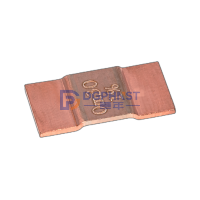Depth analysis of shunt resistance
1、 Definition and Principle
Diverter resistor is a low resistance, high-precision resistor designed specifically for current measurement. Its core function is to convert high current signals in the circuit into measurable voltage signals. According to Ohm's Law (I=RV), when a current passes through a shunt, a small voltage drop proportional to the current will be generated at both ends, and the current value can be inferred by measuring this voltage. Typical features include:
Ultra low resistance: usually in the micro ohm (μ Ω) to milliohm (m Ω) range (such as 0.05m Ω~4m Ω) to minimize the impact on the circuit.

High precision and low-temperature drift: The accuracy can reach ± 0.1%, and the temperature coefficient is as low as ± 5ppm/℃, ensuring measurement stability.
Power tolerance: can withstand currents of hundreds or even thousands of amperes, with low power loss.
2、 Application Fields
Diverter resistors are widely used in scenarios that require high-precision current monitoring:
Power monitoring: Real time monitoring of grid current to ensure safe operation of equipment.
Electric vehicles: Monitor charging and discharging currents in the battery management system to optimize battery performance.
Industrial automation: Monitor the current of equipment such as motors and power supplies to achieve fault warning.
Energy storage system: Monitor output current in photovoltaic inverters and wind power generation systems to ensure system stability.
Consumer electronics: power management modules for smartphones and tablets.
3、 Type and Characteristics
According to their structure and application scenarios, shunt resistors can be classified into the following types:
4、 Key selection points
When selecting a shunt resistor, the following factors should be considered comprehensively:
Current range and resistance value: Select the resistance value (R) based on the maximum current (Imax) to ensure that the voltage drop (V=Imax × R) is within the measuring device range.
Accuracy and temperature drift: For high-precision scenarios (such as medical equipment), a ± 0.1% accuracy and a low-temperature drift (± 5ppm/℃) model should be selected.
Power capacity: Calculate the power loss (P=I2 × R) and select the model with a rated power higher than the actual loss.
Packaging and size: Choose patch or plug-in based on PCB layout to ensure heat dissipation performance.
Certification and reliability: Automotive grade applications require AEC-Q200 certification, while industrial applications must comply with IEC standards.
5、 Development Trends
Miniaturization and integration: With the miniaturization of electronic devices, the demand for surface mount splitters is increasing, and the size is evolving towards 0201 and 0402 packages.
High precision and low temperature drift: New energy vehicles and 5G communication promote the popularization of ± 0.01% precision and ± 1ppm/℃ temperature drift products.
Intelligent functions: integrating temperature compensation, self calibration, digital interfaces (such as I ² C/SPI) and other functions to enhance system reliability.
Application of new materials: Low temperature coefficient materials such as manganese copper and nickel chromium are used to improve stability.
Environmental Protection and Energy Efficiency: Lead free and low-energy design complies with RoHS standards, contributing to carbon neutrality goals.
6、 Typical manufacturers and products
Shenzhen Yezhan Electronics: Provides FHR series splitters with a resistance range of 0.05m Ω~4m Ω, accuracy of ± 0.1%, and temperature drift of ± 5ppm/℃.
Fenghua High tech: launches automotive grade splitter, certified by AEC-Q200, suitable for electric vehicle BMS.
Vishay: The WSN series high-power splitter has a power of up to 3W and a resistance as low as 0.1m Ω, suitable for industrial motor drive.
The shunt resistor, as the core component for current measurement, achieves precise monitoring of large currents through low resistance and high-precision design, and is widely used in fields such as power, automotive, and industry. With the advancement of technology, it is developing towards miniaturization, intelligence, and high reliability, meeting the needs of emerging markets such as new energy and 5G.
